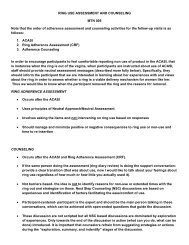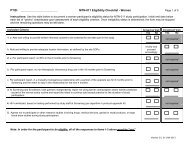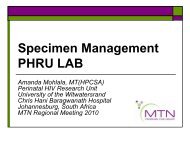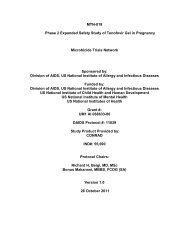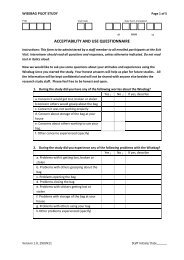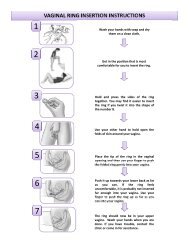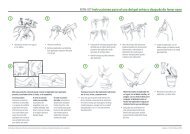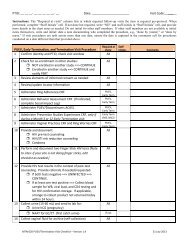Hematology, Chemistry, Coagulation: Helpful Hints
Hematology, Chemistry, Coagulation: Helpful Hints
Hematology, Chemistry, Coagulation: Helpful Hints
Create successful ePaper yourself
Turn your PDF publications into a flip-book with our unique Google optimized e-Paper software.
<strong>Hematology</strong>, <strong>Chemistry</strong>,<br />
<strong>Coagulation</strong><br />
<strong>Helpful</strong> <strong>Hints</strong>
<strong>Hematology</strong><br />
• A good check to see if your<br />
Complete Blood Counts on your<br />
patient results are valid is the<br />
“RULE OF THREE”
<strong>Hematology</strong><br />
Rules of Three for normal <strong>Hematology</strong><br />
Rule #1<br />
Hgb X 3 = Hct +/-2<br />
Rule #2<br />
RBC x 3.3 = Hgb +/- 1.5<br />
Rule #3<br />
RBC x 9 = Hct +/3
<strong>Hematology</strong><br />
• The laboratory must verify<br />
calibration on the instrument<br />
every 6 months or on an “as<br />
needed” basis to ensure<br />
accuracy of the system.
<strong>Hematology</strong><br />
• And why else would calibration be<br />
necessary?<br />
1. Critical parts are replaced such as<br />
manometers, apertures, or detector<br />
circuit boards<br />
2. Controls show an unusual trend or<br />
are outside of acceptable limits and<br />
cannot be corrected by<br />
maintenance or troubleshooting.
<strong>Hematology</strong><br />
• Low platelet counts on an individual<br />
that has no bleeding symptoms, try<br />
checking the blood smear for platelet<br />
clumping or platelets satelliting<br />
around the neutrophils
<strong>Hematology</strong><br />
• To help correct this problem, use<br />
sodium citrate as an alternative<br />
anticoagulant (because EDTA<br />
induced platelet clumping) and<br />
multiply the citrate platelet count and<br />
WBC by 1.11 to correct for<br />
anticoagulant dilution
<strong>Hematology</strong><br />
• What should you be doing if you<br />
have two different hematology<br />
instruments?<br />
• Or if you have two instruments that<br />
are the same
<strong>Hematology</strong><br />
• Comparison check
<strong>Hematology</strong><br />
Do not use non Clorox bleach or any<br />
scented Clorox bleach for cleaning<br />
the instruments.<br />
If you can not get Clorox, then
<strong>Chemistry</strong><br />
• The laboratory must very calibration<br />
every six months or on an “as<br />
needed” basis to ensure accuracy of<br />
the system.
<strong>Chemistry</strong><br />
• And why else would calibration be<br />
necessary?<br />
1.Critical parts are replaced<br />
2.Controls show an unusual trend or<br />
are outside of acceptable limits and<br />
cannot be corrected by maintenance<br />
or troubleshooting.
<strong>Coagulation</strong><br />
• If you are using a manual or semiautomated<br />
method for your APTTs,<br />
the timing of the incubation of your<br />
“patient plasma + reagent” is critical.<br />
The Timing of your duplicate testing<br />
needs to be precise. Any deviations<br />
in timing will usually result in the<br />
duplicate test results not matching.
• The tests needs to be run with the<br />
same timing limits as the controls.<br />
• So what does that mean you should<br />
be checking?
<strong>Coagulation</strong><br />
• Your timer!
• Controls (normal and abnormal) are<br />
typically valid for one year.<br />
• Ranges are not established so you<br />
must establish your own ranges.<br />
• Run the controls a minimum of 30<br />
times to establish the mean and<br />
SDs.
Quality Control<br />
• Internal Quality Control<br />
• Reagent Check (Parallel Testing)<br />
• External Quality Control (proficiency<br />
programs)<br />
• Blind Samples<br />
• Competency Checks
• Quality control material<br />
• Quality control ranges<br />
• Plotting results (Levey-Jennings<br />
Graphs)<br />
• Reviewing Results<br />
• Corrective Action Logs<br />
• Reagent Checks (parallel testing)<br />
• Review & Signature
• Do you have appropriate controls for<br />
each procedure?<br />
Quantitative: low (normal) & high<br />
normal & abnormal
• Do you treat your control material<br />
like the patient samples?<br />
• Are the control results verified<br />
BEFORE patient results are<br />
released?
• How often do you run your controls?<br />
*per manufacturers instructions<br />
*per laboratory guidelines<br />
*can always run more than<br />
recommendation<br />
*balance time, cost and efficacy
“General Guidelines”<br />
CBC: per 8 hour shift<br />
Manual Differentials/BPS: per day<br />
(stain check)<br />
<strong>Chemistry</strong>: per 8 hour shift
• Document results on run sheet or QC log<br />
• Include lot #’s & expiration dates<br />
• Include tech initials & run date<br />
• For QT assays,<br />
SD)<br />
Manufacturers Mean & Range (~+2.5<br />
Internal Mean + 2 & 3 SD<br />
Levey-Jennings Control Charts
• Why use Levey-Jennings control<br />
charts?<br />
• Patterns<br />
1:2s, 1:3s<br />
Dispersion (loss of precision)<br />
Trend<br />
Shift
• Lab supervisor review if exceeded<br />
(*before patient results are<br />
released)<br />
• Corrective action if needed<br />
(document)<br />
• Retest if required
• QC ‘failures’ must be reviewed and<br />
signed off by lab supervisor or higher<br />
• All unexpected or failed QC results must<br />
be documented – Corrective Action Log<br />
• Final action must demonstrate problem<br />
was resolved<br />
• Lab Sup/Mgr must review/sign CA Logs<br />
at least monthly<br />
• Must have CA log for every<br />
test/equipment/system
• Why do parallel testing?<br />
Consistency of patient results<br />
Transition of control
• <strong>Chemistry</strong>: New control lot in<br />
parallelàmean/SD<br />
• CBC/FBC: New control lot in<br />
parallel 3-5 days
• At the October Meeting:<br />
– Westgard Rules<br />
– Normal Values<br />
– QC and corrective action<br />
– QA<br />
– Instrument Validation<br />
– Carryover Studies




